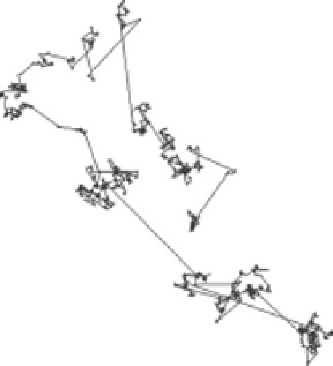Information Technology Reference
In-Depth Information
Figure 4.5.
The landing sites for the Weierstrass walk are depicted and the islands of clusters are readily
seen.
larger spatial scale. This walk generates a hierarchy of clusters, which are statistically
self-similar; see for example Figure
4.5
. The parameter
a
determines the number
of subclusters within a cluster and the parameter
b
determines the spatial scale size
between clusters.
The renormalization-group analysis done previously can be used to determine the
properties of the present fractal walk. Consider the structure-function argument in (
4.23
)
scaled by the parameter
b
,
∞
a
−
1
1
a
n
cos
b
n
+
1
k
p
bk
=
(
),
(4.24)
a
n
=
0
so that, on shifting the summation index by unity, we have the renormalization equation
a
−
1
p
bk
=
a
p
k
−
cos
k
.
(4.25)
a
p
h
and a singular
The solution to the scaling equation consists of a homogeneous part
p
s
and the details for the derivation of the homogeneous part are given in Hughes
et al
.[
25
]. The singular part relies on the arguments presented earlier in the analysis of
the Weierstrass function,
part
p
bk
=
p
k
,
a
(4.26)
and yields the solution
∞
p
k
H
n
A
n
|
|
=
k
(4.27)
n
=−∞
with the complex power-law indices
ln
a
ln
b
+
i
n
2
π
ln
b
=
μ
+
i
n
2
π
ln
b
.
H
n
=
(4.28)






